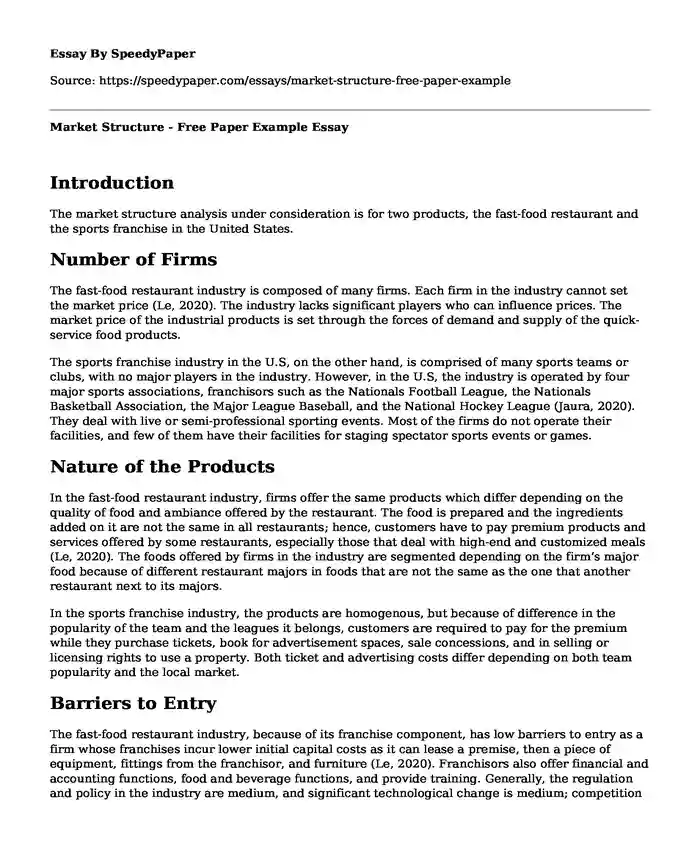
| Type of paper: | Essay |
| Categories: | Marketing United States Analysis Sport Fast food |
| Pages: | 3 |
| Wordcount: | 815 words |
Introduction
The market structure analysis under consideration is for two products, the fast-food restaurant and the sports franchise in the United States.
Number of Firms
The fast-food restaurant industry is composed of many firms. Each firm in the industry cannot set the market price (Le, 2020). The industry lacks significant players who can influence prices. The market price of the industrial products is set through the forces of demand and supply of the quick-service food products.
The sports franchise industry in the U.S, on the other hand, is comprised of many sports teams or clubs, with no major players in the industry. However, in the U.S, the industry is operated by four major sports associations, franchisors such as the Nationals Football League, the Nationals Basketball Association, the Major League Baseball, and the National Hockey League (Jaura, 2020). They deal with live or semi-professional sporting events. Most of the firms do not operate their facilities, and few of them have their facilities for staging spectator sports events or games.
Nature of the Products
In the fast-food restaurant industry, firms offer the same products which differ depending on the quality of food and ambiance offered by the restaurant. The food is prepared and the ingredients added on it are not the same in all restaurants; hence, customers have to pay premium products and services offered by some restaurants, especially those that deal with high-end and customized meals (Le, 2020). The foods offered by firms in the industry are segmented depending on the firm’s major food because of different restaurant majors in foods that are not the same as the one that another restaurant next to its majors.
In the sports franchise industry, the products are homogenous, but because of difference in the popularity of the team and the leagues it belongs, customers are required to pay for the premium while they purchase tickets, book for advertisement spaces, sale concessions, and in selling or licensing rights to use a property. Both ticket and advertising costs differ depending on both team popularity and the local market.
Barriers to Entry
The fast-food restaurant industry, because of its franchise component, has low barriers to entry as a firm whose franchises incur lower initial capital costs as it can lease a premise, then a piece of equipment, fittings from the franchisor, and furniture (Le, 2020). Franchisors also offer financial and accounting functions, food and beverage functions, and provide training. Generally, the regulation and policy in the industry are medium, and significant technological change is medium; competition is high; then, the life cycle stage is mature, and the level of concentration of firms is low to moderate.
In the sports franchise industry, the barriers to entry are high and increasing. The extremely high barriers to entry are because the leagues’ officers approve any franchise, and it is then the remaining owners’ votes (Jaura, 2020). The leagues are under strict governance, and the number of teams is controlled. The payrolls are copped, and revenue is shared. The major barriers are heavy regulation and policy, then the high competition.
Price Control
The fast-food restaurant industry is characterized by heavy-price based competition. Firms set different prices for new products introduced into their list and according to the ingredients they use. The prices for new products are set for a certain period of time as the firms protect the formula in which they prepare the new food. The foods and beverages offered in the restaurants are not exactly the same; hence, the prices for the same products might differ by a small figure. The restaurants set the prices above the cost of preparing the foods, and it is adjusted by considering the prices of competitors and by demand forces.
In the sports franchise industry, the sports teams or clubs set the prices of their products and services with regard to their locality and the popularity of the team (Jaura, 2020). A more popular team sells tickets at a higher price and charges higher advertising costs because it attracts more viewers to their stadiums. However, the charges on the products are controlled to some extent by the four sports associations, which are the franchisors.
Conclusion
The type of market in which the fast-food restaurant is sold is a perfectly competitive market. The reason being, the industry is characterized by many sellers, which are restaurants and many buyers. Also, there are no barriers to entry and exit, and all the products being dealt with are homogenous. Both sellers and buyers in the industry have knowledge of the products and services being provided.
In the sports franchise, the type of the market being sold is monopolistically competitive because the firms in the industry are many, and customers are many. But there are barriers to entry because of heavy regulations and policy.
References
Jaura. R. (2020). Sports Franchises in the U.S. IBISWorldLe. T. (2020). Fast Food Restaurants in the U.S. IBISWorld.
Cite this page
Market Structure - Free Paper Example. (2023, Dec 12). Retrieved from https://speedypaper.net/essays/market-structure-free-paper-example
Request Removal
If you are the original author of this essay and no longer wish to have it published on the SpeedyPaper website, please click below to request its removal:
- Effects of Exports Amount on the GDP of African Countries
- Free Essay: Manuscript Speech about LeBron James
- Essay Sample on The Current State of Tourism in Western Australia
- Essay Sample on Logistics, Planning, and Management
- Essay Sample on Football Business and Marketing
- Essay Sample: Comparison of Worker's Protection in USA and Pennsylvania
- Essay Sample on How to Start College Right: Set the Course for Your Future
Popular categories




